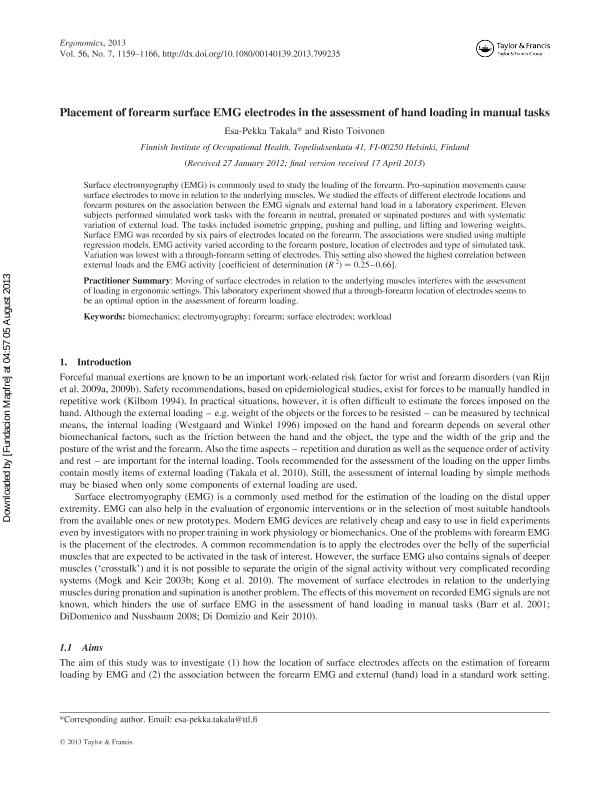Placement of forearm surface EMG electrodes in the assessment of hand loading in manual tasks

Contenido multimedia no disponible por derechos de autor o por acceso restringido. Contacte con la institución para más información.
| Tag | 1 | 2 | Value |
|---|---|---|---|
| LDR | 00000cab a2200000 4500 | ||
| 001 | MAP20130025407 | ||
| 003 | MAP | ||
| 005 | 20130829132100.0 | ||
| 008 | 130805e20130701esp|||p |0|||b|spa d | ||
| 040 | $aMAP$bspa$dMAP | ||
| 084 | $a875 | ||
| 100 | 1 | $0MAPA20130010823$aTakala, Esa-Pekka | |
| 245 | 1 | 0 | $aPlacement of forearm surface EMG electrodes in the assessment of hand loading in manual tasks$cEsa-Pekka Takala, Risto Toivonen |
| 520 | $aSurface electromyography (EMG) is commonly used to study the loading of the forearm. Pro-supination movements cause surface electrodes to move in relation to the underlying muscles. We studied the effects of different electrode locations and forearm postures on the association between the EMG signals and external hand load in a laboratory experiment. Eleven subjects performed simulated work tasks with the forearm in neutral, pronated or supinated postures and with systematic variation of external load. The tasks included isometric gripping, pushing and pulling, and lifting and lowering weights. Surface EMG was recorded by six pairs of electrodes located on the forearm. The associations were studied using multiple regression models. EMG activity varied according to the forearm posture, location of electrodes and type of simulated task. Variation was lowest with a through-forearm setting of electrodes. This setting also showed the highest correlation between external loads and the EMG activity [coefficient of determination (R 2) = 0.250.66]. | ||
| 773 | 0 | $wMAP20100019818$tErgonomics : the international journal of research and practice in human factors and ergonomics$dOxon [United Kingdom] : Taylor & Francis, 2010-$x0014-0139$g01/07/2013 Volumen 56 Número 7 - julio 2013 |

